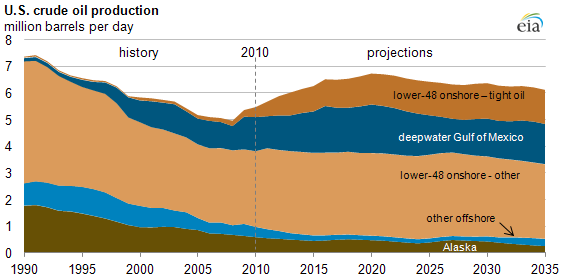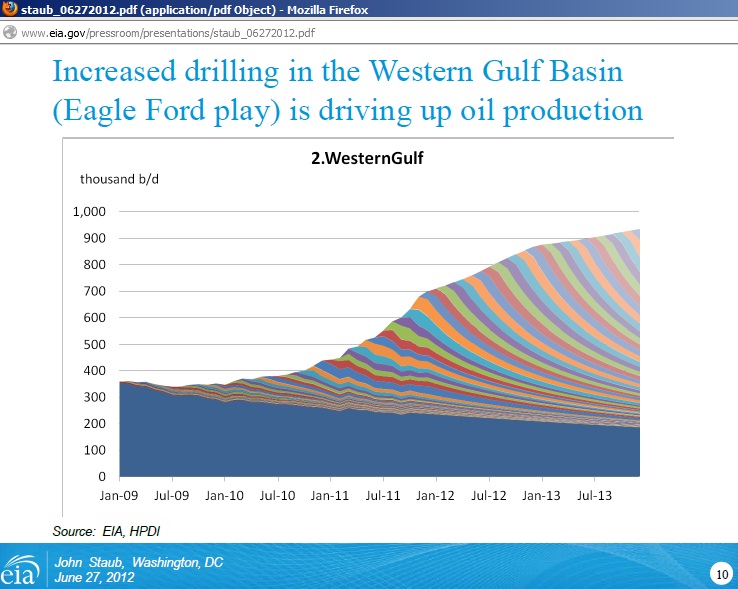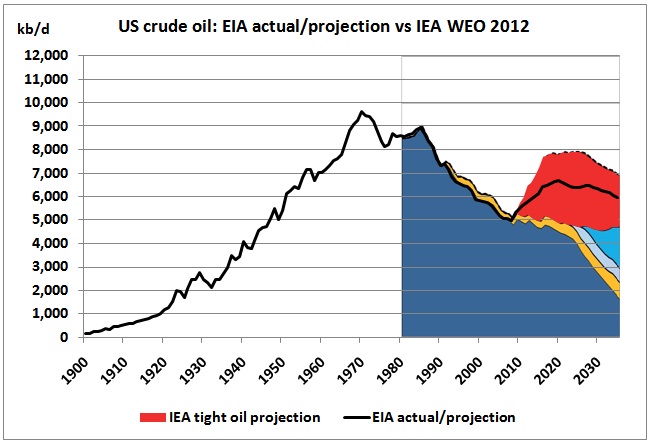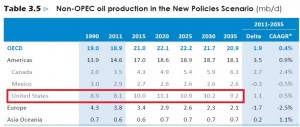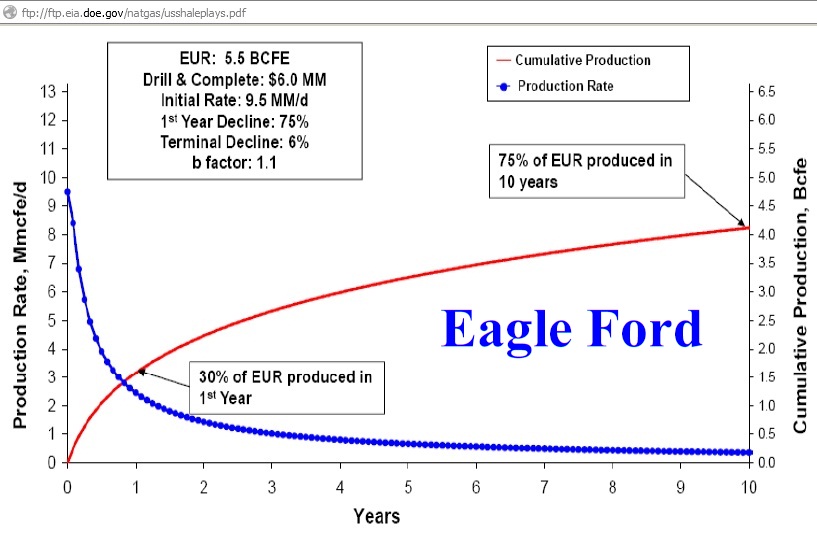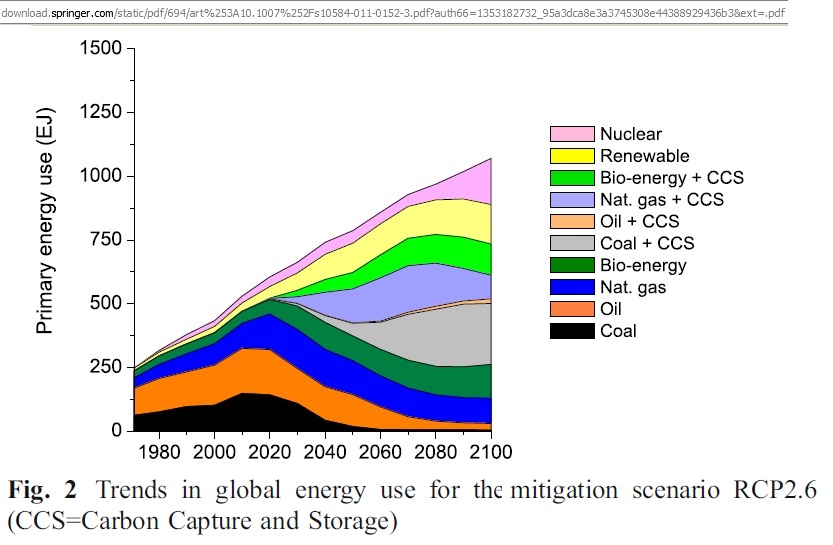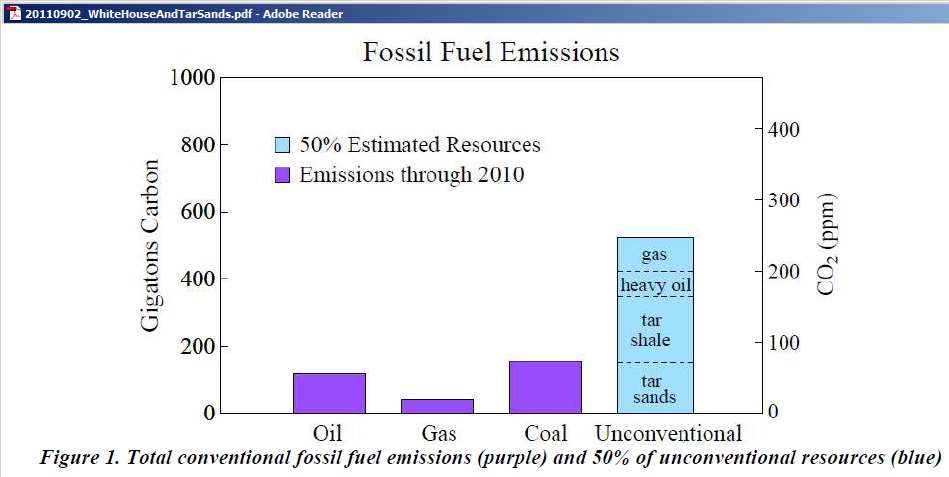The media are full of reports – quoting the recently published World Energy Outlook of the International Energy Agency (IEA) – about an energy revolution in the US, which is going to change global oil and gas markets. In this article, we look at shale oil only.
Contents:
(1) IEA tight oil forecast exceeds highest EIA scenario
(2) Tight oil peak not higher than Alaska peak
(3) US tight oil peak lower than Saudi crude oil peak (Husseini projection)
(4) US oil liquids production marginally overtaking Saudi oil production for 10 years
(5) EIA’s oil liquids do not reach IEA’s Saudi oil forecast
(6) US not a net oil exporter by 2035
(7) EIA’s projections show US net oil imports still at 7.5 mb/d in 2035
(8) Drill, baby, drill – 220,000 wells
(9) Tight oil does not bring WTI prices down
(10) Global 2012 crude spike caused by US tight oil
(11) US tight oil will contribute to temperature increase > 2 °C
(12) Misinformation and confusion by the media
Introduction
What are the main statements in the WEO 2012 in relation to shale oil (tight oil)?
(I) On page 3, the reader is conditioned for a positive surprise:
“Finally, one remarkable feature of the market, to which we draw attention this year, is an energy transformation in the United States. Due to a combination of new technology, free markets and policy action, the United States is well on the way to becoming self-sufficient in energy, in net terms.”
(II) On page 23:
“ The recent rebound in US oil and gas production, driven by upstream technologies that are unlocking light tight oil and shale gas resources, is spurring economic activity – with less expensive gas and electricity prices giving industry a competitive edge – and steadily changing the role of North America in global energy trade. By around 2020, the United States is projected to become the largest global oil producer (overtaking Saudi Arabia until the mid-2020s) and starts to see the impact of new fuel-efficiency measures in transport. The result is a continued fall in US oil imports, to the extent that North America [not US] becomes a net oil exporter around 2030. This accelerates the switch in direction of international oil trade towards Asia, putting a focus on the security of the strategic routes that bring Middle East oil to Asian markets. The United States, which currently imports around 20% of its total energy needs, becomes all but self-sufficient in net terms – a dramatic reversal of the trend seen in most other energy-importing countries.”
(III) On page 76
“The projected reduction in US net oil imports, from 9.5 mb/d in 2011 to 3.4 mb/d in 2035, is a product of changes both on the supply side and demand sides (Figure 2.17). The impact of increased supply, mainly due to expanded production of light tight oil, predominates early in the projection period. After 2020, though, the bulk of the reduction is attributable to developments on the demand side – a big improvement in the fuel-efficiency of vehicles – as well as the use of biofuels and natural gas in the transport sector. …… But reduced dependence on imported oil does not mean, of course, that the United States will be immune to developments in international markets. Oil prices are set globally, so consumers in the United States will continue to feel the effects of worldwide price fluctuations. Moreover, there is not necessarily a direct correlation between levels of import dependency and the security or insecurity of energy supply.”
We start by looking at this graph from the WEO 2012:
 (a) miraculously, fields yet-to-be developed and found just about offset decline in currently producing fields.
(a) miraculously, fields yet-to-be developed and found just about offset decline in currently producing fields.
(b) natural gas liquids have been sandwiched between conventional crude oil and tight oil, obscuring the crude oil story
What are the actual crude oil data up to now?
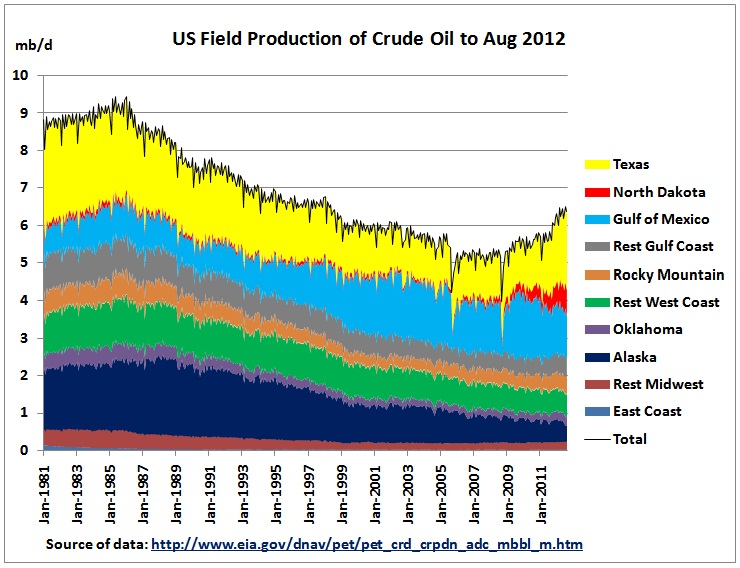 Data from: http://www.eia.gov/dnav/pet/pet_crd_crpdn_adc_mbbl_m.htm
Data from: http://www.eia.gov/dnav/pet/pet_crd_crpdn_adc_mbbl_m.htm
What we see:
(a) Alaska is in terminal decline
(b) Offshore Gulf of Mexico has peaked
(c.) Around 56% of total crude production is either stagnating or in decline since 1986 at a rate of 2.2% pa
(d) An uptick of production comes from North Dakota (Bakken) and Texas (Eagle Ford)
(1) IEA tight oil forecast exceeds highest EIA scenario
Let’s check how the tight oil part of the IEA Fig 3.18 compares with the EIA’s Annual Energy Outlook 2012, published in June 2012:
http://www.eia.gov/todayinenergy/detail.cfm?id=4910
These are the 4 scenarios presented in this report
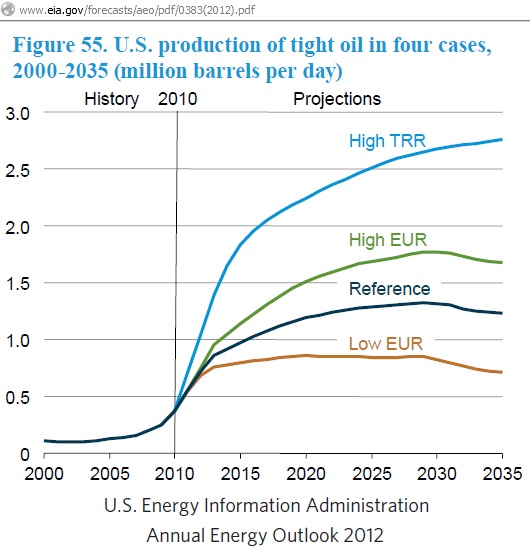 TRR = Technically Recoverable Resources, EUR = Estimated Ultimate Recovery
TRR = Technically Recoverable Resources, EUR = Estimated Ultimate Recovery
Low EUR: EUR per well 50% lower than reference case (17 Gb)
Reference EUR: 33 Gb
High EUR: 50% higher than reference (50 Gb)
High TRR: as high EUR, but 8 wells per sqm (89 Gb)
“….more than 630,000 new wells would be needed to bring total U.S. shale gas and tight oil resources into production. In 2010, roughly 37,500 total oil and natural gas wells were drilled in the United States. It takes time and money to evaluate, develop, and produce hydrocarbon resources.” p 59
http://www.eia.gov/forecasts/aeo/pdf/0383(2012).pdf http://www.eia.gov/forecasts/aeo/
We superimpose the IEA WEO 2012 forecast with the low/high estimate graph:
 We can clearly see that the IEA forecast is even higher than the highest EIA scenario. And that’s how some of the production profiles look like:
We can clearly see that the IEA forecast is even higher than the highest EIA scenario. And that’s how some of the production profiles look like: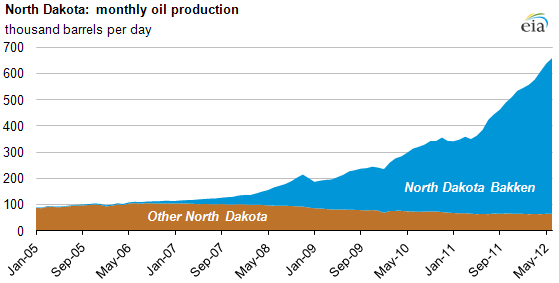
http://www.eia.gov/todayinenergy/detail.cfm?id=7550
Note that there are pipeline and takeaway capacity constraints as described here:
http://www.eia.gov/todayinenergy/detail.cfm?id=5870
http://www.eia.gov/pressroom/presentations/staub_06272012.pdf
This graph shows how many fields have to be developed (and maintained) to increase production. There are kinks in the curve meaning it’s going to get harder and harder to sustain growth.
The superimposition of production profiles from various shale oil provinces and a comparison with the highest case scenario in the WEO 2012 goes beyond the scope of this article.
(2) Tight oil peak not higher than Alaska peak
IEA’s graph includes natural gas liquids. So we need to restack the graph in order to see what’s happening to crude oil: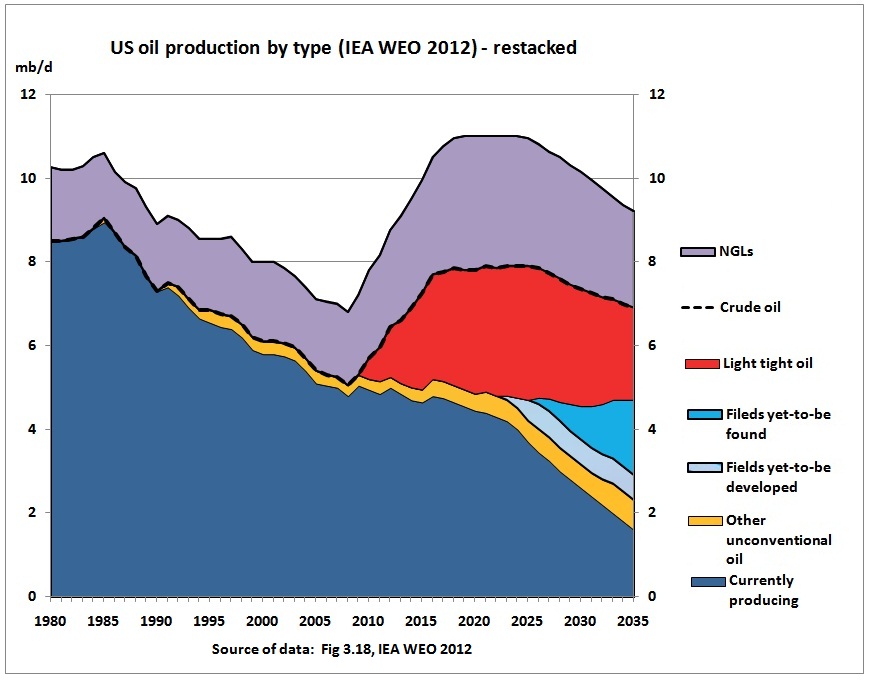 We see that the tight oil peak (in light red) will not be higher than the Alaska peak (in dark blue) in the mid 80s and not be higher than the 1970 peak:
We see that the tight oil peak (in light red) will not be higher than the Alaska peak (in dark blue) in the mid 80s and not be higher than the 1970 peak:
http://www.eia.gov/dnav/pet/hist/LeafHandler.ashx?n=PET&s=MCRFPUS2&f=A
(3) US tight oil peak lower than Saudi crude oil peak (Husseini projection)
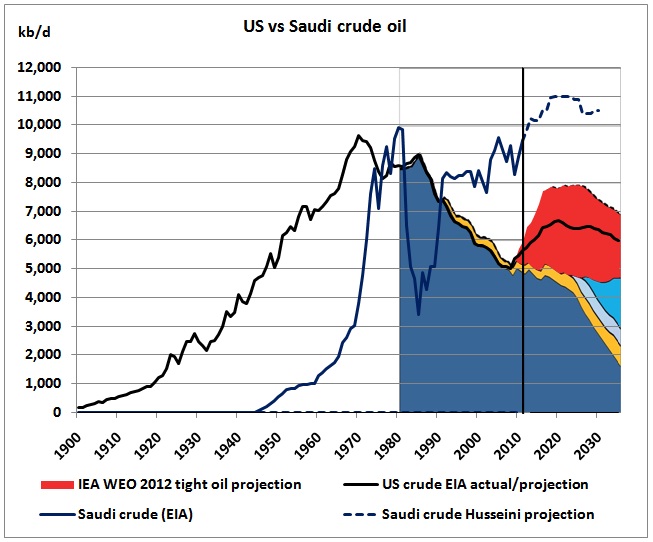 Note the different oil production history of Saudi Arabia (swing producer in the 1980s) compared to the US. If Saudi crude production continued at current levels of 9.5 mb/d the IEA WEO 2012 projection would not reach that production level, nor Husseini’s projection at between 10 mb/d and 11 mb/d.
Note the different oil production history of Saudi Arabia (swing producer in the 1980s) compared to the US. If Saudi crude production continued at current levels of 9.5 mb/d the IEA WEO 2012 projection would not reach that production level, nor Husseini’s projection at between 10 mb/d and 11 mb/d.
More details on Husseini’s projection can be found in this article
24/9/2012
Minesweeping exercise near Saudi oil hub
http://crudeoilpeak.info/minesweeping-exercise-near-saudi-oil-hub
(4) US oil liquids production marginally overtaking Saudi oil production for 10 years
Using tables 3.5 and 3.6 of the WEO 2012 (click on table to enlarge)
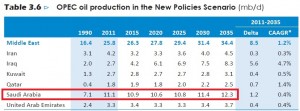 we arrive at this impressive graph:
we arrive at this impressive graph:
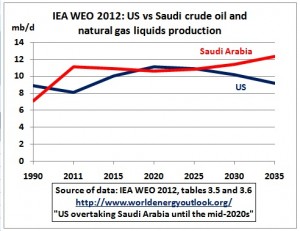 At best – given the uncertainties in projections – we could call this a race. By no means is it guaranteed that Saudi production will go up in 20 years time so what we see is double spin.
At best – given the uncertainties in projections – we could call this a race. By no means is it guaranteed that Saudi production will go up in 20 years time so what we see is double spin.
(5) EIA’s oil liquids do not reach IEA’s Saudi oil forecast
From the EIA Annual Energy Outlook 2012, Fig 111
 “Other” contains processing gains at US refineries, including those obtained from imported crude oil. In June 2012, the ratio of local crude to total crude was 6.19/(6.19+9.05) = 40%. Therefore, 60% of processing gains of 1.1 mb/d = 0.66 mb/d actually come from imported crude.
“Other” contains processing gains at US refineries, including those obtained from imported crude oil. In June 2012, the ratio of local crude to total crude was 6.19/(6.19+9.05) = 40%. Therefore, 60% of processing gains of 1.1 mb/d = 0.66 mb/d actually come from imported crude.
So for our purposes we need to split up the processing gains and restack this graph so that we can compare it with IEA’s petroleum liquids for the US and Saudi Arabia:
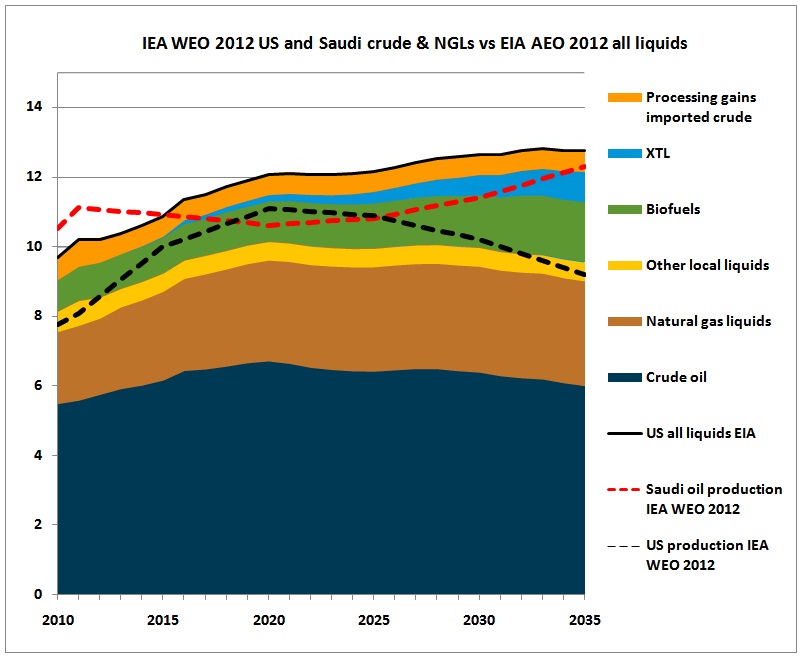 We can see that crude oil (dark blue), natural gas liquids (light brown) and other local liquids (yellow, mainly processing gains from local crude) forecast by the EIA would not reach IEA’s Saudi forecast. So this gives us a hint as to why the IEA increased their tight oil forecast.
We can see that crude oil (dark blue), natural gas liquids (light brown) and other local liquids (yellow, mainly processing gains from local crude) forecast by the EIA would not reach IEA’s Saudi forecast. So this gives us a hint as to why the IEA increased their tight oil forecast.
(6) US not a net oil exporter by 2035
From table 3.2 (oil demand by region, p 85) and table 3.5 (Non-OPEC oil production, p 107) we take the IEA data and put them in a graph
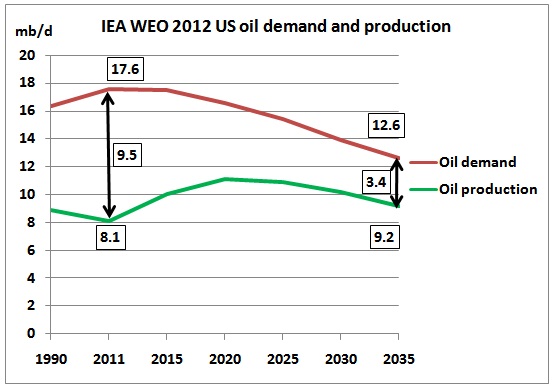 The IEA assumes that US oil demand can be reduced by 5 mb/d by 2035, reducing net oil imports from 9.5 mb/d to 3.4 mb/d. By no means does this graph show that the US will miraculously become a net oil exporter.
The IEA assumes that US oil demand can be reduced by 5 mb/d by 2035, reducing net oil imports from 9.5 mb/d to 3.4 mb/d. By no means does this graph show that the US will miraculously become a net oil exporter.
And the 5 mb/d oil demand reduction will be a tough job as shown in Fig 2.17
 Eye-balling the yellow area, oil demand reduction from efficiency improvements in oil use is 3.8 mb/d by 2035, that is 22% of 17.6 mb/d. Note that despite the assumed shale gas boom only a very small fraction of the oil demand is planned to be replaced by natural gas in the transport sector.
Eye-balling the yellow area, oil demand reduction from efficiency improvements in oil use is 3.8 mb/d by 2035, that is 22% of 17.6 mb/d. Note that despite the assumed shale gas boom only a very small fraction of the oil demand is planned to be replaced by natural gas in the transport sector.
We may remember that 1 year ago APEC declared a target of reducing energy intensities by 45% by 2035.
 The IEA assumes a GDP growth rate for the US of 2.4% (table 1.2, p 37) so the oil intensity reduction for a demand reduction of 3.8 mb/d is 56%. The minimum GDP growth rate to achieve a 45% reduction is 1.5 % pa. Should the growth fall below this threshold oil demand would have to be reduced by more than 3.8 mb/d.
The IEA assumes a GDP growth rate for the US of 2.4% (table 1.2, p 37) so the oil intensity reduction for a demand reduction of 3.8 mb/d is 56%. The minimum GDP growth rate to achieve a 45% reduction is 1.5 % pa. Should the growth fall below this threshold oil demand would have to be reduced by more than 3.8 mb/d.
(7) EIA’s projections show US net oil imports still at 7.5 mb/d in 2035
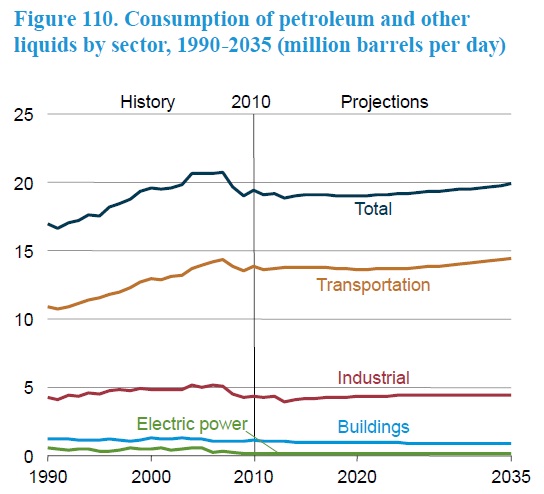 Here, total liquid consumption does not go down at all. Note that demand growth ended in 2004/05. This is peak oil, not a voluntary or even environmentally motivated reduction.
Here, total liquid consumption does not go down at all. Note that demand growth ended in 2004/05. This is peak oil, not a voluntary or even environmentally motivated reduction.
Consequently, net oil imports are still around 7.5 mb/d in 2035
(8) Drill, baby, drill – 220,000 wells
The IEA correctly quotes in box 3.3 EIA’s “unproven recoverable resources” of 33 Gb.
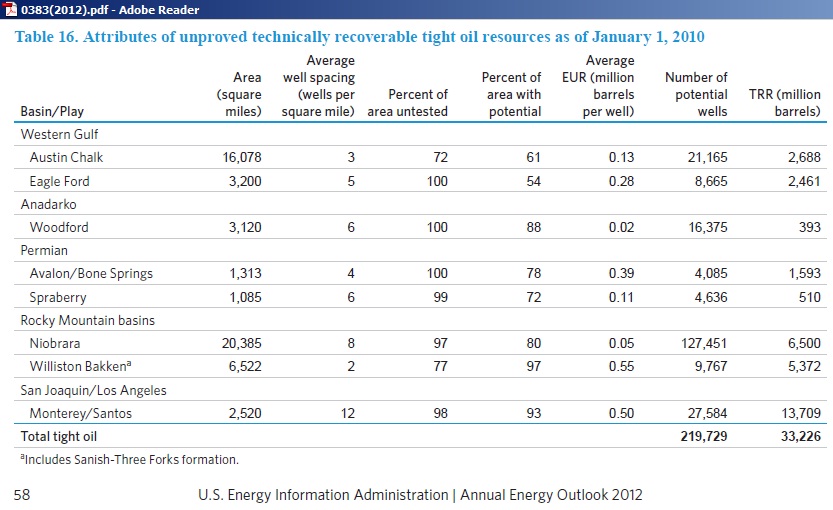 The table above shows the number of wells required to access this resource is around 220,000. Remember that there are another 410,000 wells to be drilled for shale gas so this program will be in competition to the shale oil drilling. The following excerpt shows to which length (=destruction of landscape) the industry has to go to keep costs down:
The table above shows the number of wells required to access this resource is around 220,000. Remember that there are another 410,000 wells to be drilled for shale gas so this program will be in competition to the shale oil drilling. The following excerpt shows to which length (=destruction of landscape) the industry has to go to keep costs down:
“One of the industry’s more recent innovations, pad-to-pad moves, underscores the efficiency gains from rig mobility and pad drilling. During the drilling operation pictured below, rig operator Nabors Industries transported a fully-assembled drilling rig about one mile between drill sites. The cost of rigging down and rigging back up can be high enough that producers may find it more efficient to build a road between two pads, transport the rig intact, and have it arrive ready to drill the next well.”
 http://www.eia.gov/todayinenergy/detail.cfm?id=7910
http://www.eia.gov/todayinenergy/detail.cfm?id=7910
“At the beginning of a shale play’s development, high initial well production rates result in significant production growth as drilling activity in the play increases. The length of time over which the rapid growth can be sustained depends on the size of the technically recoverable resource in each play, the rate at which drilling activity increases, and the extent of the play’s “sweet spot” area [115]. In the longer term, production growth tapers off as high initial production rates of new wells in “sweet spots” are offset by declining rates of existing wells, and as drilling activity moves into less-productive areas. As a result, in the later stages of a play’s resource development, maintaining a stable production rate requires a significant increase in drilling.” p 57 EIA AEO 2012
It is well known that shale oil wells decline very fast.
ftp://ftp.eia.doe.gov/natgas/usshaleplays.pdf
In a typical well, 30% of the oil ever produced will have already been extracted in just 12 months.
(9) Tight oil does not bring WTI prices down
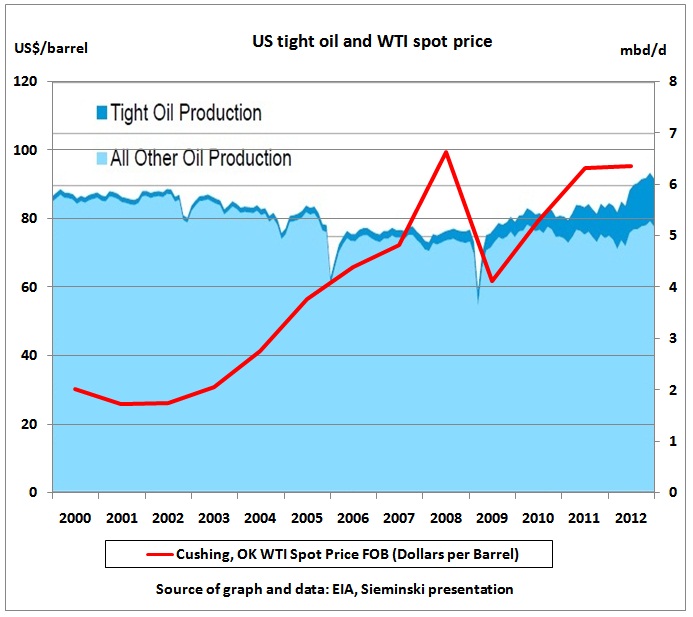 We can see that tight oil production has not brought down the WTI oil price. In fact a high oil price is needed to produce tight oil.
We can see that tight oil production has not brought down the WTI oil price. In fact a high oil price is needed to produce tight oil.
“Changes in domestic oil production have only a modest impact on domestic crude oil and petroleum product prices, because any change in domestic oil production is diluted by the much larger world oil market. The United States produced 5.5 million barrels per day, or 7 percent of total world crude oil production of 73.9 million barrels per day in 2010 and is projected generally to maintain that share of world crude oil production through 2035 in the Reference case.” p 61, EIA AEO 2012.
(10) Global 2012 crude spike caused by US tight oil
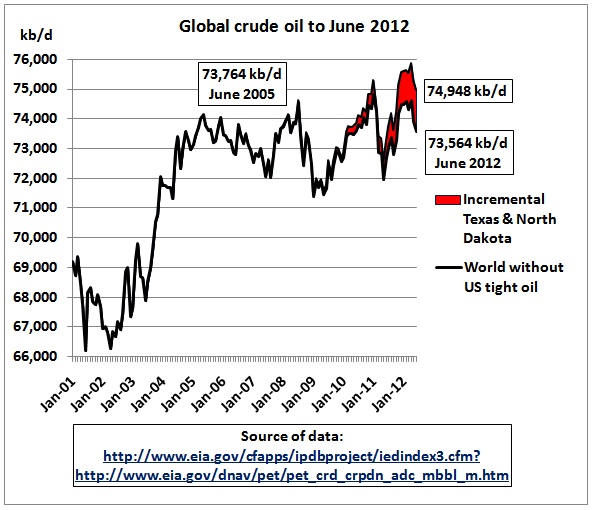 Using data from the EIA http://www.eia.gov/cfapps/ipdbproject/iedindex3.cfm? and crude production by State http://www.eia.gov/dnav/pet/pet_crd_crpdn_adc_mbbl_m.htm
Using data from the EIA http://www.eia.gov/cfapps/ipdbproject/iedindex3.cfm? and crude production by State http://www.eia.gov/dnav/pet/pet_crd_crpdn_adc_mbbl_m.htm
we see that a spike in production in 2011/12 was caused by an additional production of 1.4 mb/d from Texas and North Dakota. Without this oil, the world would have produced at 2005 levels.
(11) US tight oil will contribute to temperature increase > 2 °C
The WEO 2012 distinguishes following climate change scenarios:
- The Current Policies Scenario assumes no implementation of policies beyond those adopted by mid-2012. 950 ppm CO2
- the New Policies Scenario (central scenario), takes into account existing policy commitments and assumes that those recently announced are implemented, albeit in a cautious manner. 660 ppm CO2
- The 450 Scenario assumes policy action consistent with limiting the long-term global temperature increase to 2 °C. 450 ppm CO2
- The Efficient World Scenario adopts all economically viable steps to improve energy efficiency.
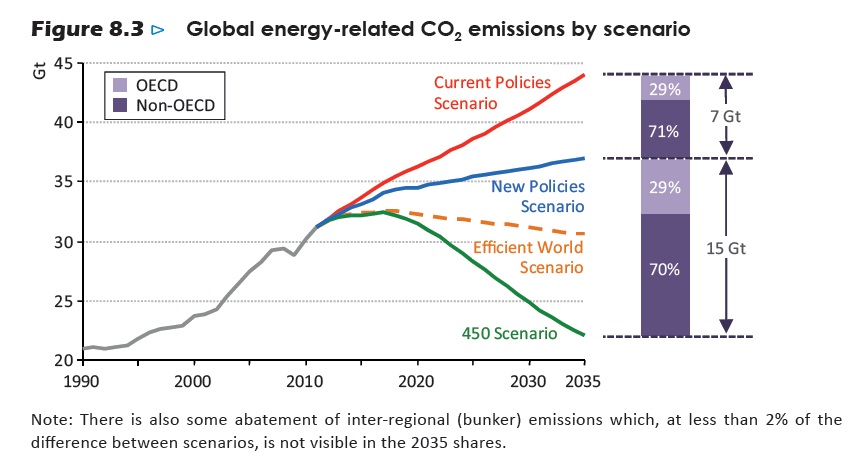 The tight oil production curve in Fig 3.18 is labelled as a “New Policies” scenario which – according to table 8.1 allows an increase of energy related emissions from 30.2 Gt pa in 2010 to 37 Gt pa by 2035 or an increase of 22.5%. However, the total tight oil volume in Fig 3.18 is appr. 23 Gb, compared to 46 Gb of other oil (existing and new fields) which is an increase of 50%. So this tight oil scenario is definitely not part of the “New Policies” scenario.
The tight oil production curve in Fig 3.18 is labelled as a “New Policies” scenario which – according to table 8.1 allows an increase of energy related emissions from 30.2 Gt pa in 2010 to 37 Gt pa by 2035 or an increase of 22.5%. However, the total tight oil volume in Fig 3.18 is appr. 23 Gb, compared to 46 Gb of other oil (existing and new fields) which is an increase of 50%. So this tight oil scenario is definitely not part of the “New Policies” scenario.
Note that burning tight oil will contribute to a world with temperature increases of more than 2 °C. Information from chapter 8:
Carbon budget for 450 ppm scenario for the period 2000 – 2050 (p 259)
Target: below 1,440 Gt
Already emitted 2000-2011: 420 Gt
Non energy related sources: 136 Gt
Balance fossil fuel burn: 884 Gt max
Fossil fuel reserves: 2,860 Gt
The WEO 2012 (p 241) concludes:
“About two-thirds of today’s total carbon reserves of 2 860 Gt CO2 – fossil-fuel reserves expressed in terms of their equivalent CO2 emissions when combusted – are concentrated in only four regions: North America, the Middle East, China and Russia. Of these carbon reserves, 74% are publicly-owned. Less than 900 Gt CO2 can be emitted up to 2050 in a 2 °C world, meaning that, in the absence of significant deployment of CCS, more than two-thirds of the current fossil-fuel reserves could not be commercialised before 2050.”
So this means for US crude oil that we can use only ⅔ x (23 Gb + 46 Gb) = 46 Gb, ie no tight oil should be used at all.
Chapter 8 mentions the IPCC scenario RCP 2.6 (Vuuren et al., 2011)
in which fossil fuel emissions have to peak by around 2020.
NASA climatologist James Hansen:
“We conclude that Earth in the warmest interglacial periods of the past million years was less than 1°C warmer than in the Holocene. Polar warmth in these interglacials and in the Pliocene does not imply that a substantial cushion remains between today’s climate and dangerous warming, but rather that Earth is poised to experience strong amplifying polar feedbacks in response to moderate global warming. Thus goals to limit human-made warming to 2°C are not sufficient – they are prescriptions for disaster.”
http://arxiv.org/ftp/arxiv/papers/1105/1105.0968.pdf
(12) Misinformation and confusion by the media
The media was mainly cherry-picking from press releases and parts of the report without doing the above analysis.
Example 1: The Sydney Morning Herald writes:
BHP greets the shale revolution
“….Because of shale, the International Energy Agency this week announced the US will overtake Saudi Arabia as the world’s top oil producer by 2017…..”
http://www.smh.com.au/business/bhp-greets-the-shale-revolution-20121113-29a4m.html
The SMH did not inform their readers that this overtaking lasts for only a couple of years.
Example 2: Al Jazeera:
US to become biggest oil producer by 2020
“The International Energy Agency says US will produce more oil than Saudi Arabia and become nearly self-sufficient by 2035”
http://www.aljazeera.com/news/americas/2012/11/20121113134836285404.html
Again, no mention by how much the US is assumed to produce more than Saudi Arabia and for how long. As the sentence mentions oil the reader is made to believe that the self-sufficiency relates to oil, while the WEO 2012 actually refers to energy self-sufficiency (incliding gas and coal)
Summary and Conclusion:
The IEA WEO 2012 (OECD, Paris) uses higher shale oil (tight oil) forecasts than the US based EIA, published just 4 months earlier. That allows the IEA to calculate a higher oil production for the US compared to Saudi Arabia, but only for 10 years. Moreover, the excess is small – just 500 kb/d – and well within the accuracy of forecasts so many years into the future. So the “US overtaking Saudi Arabia” message is neither certain to actually materialize nor very useful. An assumed Saudi production increase of 1.5 mb/d after 2025 is equally uncertain. So at best we may get a head-to-head race. Nowhere is there any statement in the WEO 2012 that the US will become oil-self-sufficient or even a net oil exporter, as often implied in media stories.
The race comes at a cost for the earth’s climate. The WEO 2012 cannot resolve the conflict between oil supply security and the need to reduce CO2 emissions. Limiting atmospheric CO2 concentrations to 450 ppm would require to leave tight oil in the ground. According to NASA climatologist James Hansen even that limit is a recipe for disaster.
EIA crude oil statistics also show that the recent surge in tight oil has caused global crude oil production to spike in 2011/12, with the rest of the world basically at 2005 levels. That cannot be called a “revolution”. Ironically, in a scenario in which there really were a substantial increase in crude production leading to a significant and sustained drop in oil prices, there would be some unwanted revolutions in oil producing countries where governments need revenue from high oil prices to keep their population happy.
Needless to say, US tight oil will not stop peak oil and its geo-political consequences in key countries like Iran, Egypt, Yemen, Sudan and Syria.
